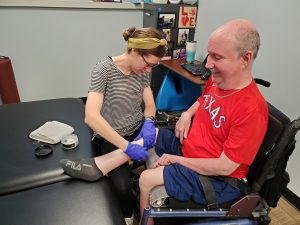Using Cupping During Physical Therapy For Patients With SMA

Recently, Michael, our patient with SMA, has exhibited some increased tenderness and reduced tissue mobility to his calf muscles bilaterally. This is no surprise since he doesn’t wear footrests and is constantly in a plantarflexed, or toe-down position. In this position, his calf muscles are constantly in a shortened length, which can quickly lead to increased tightness and tenderness in this area.


As previously discussed, Michael has had dry needling and massage to this area and many others. Another technique we have recently introduced into Michael’s treatment plan has been cupping to increase blood flow and reduce muscle tension in his calves. There are many different techniques and types of cups that can be used, but we use silicone cups and techniques called flash cupping and moveable cupping or running cupping with Michael.


Cupping is a technique that has been around since ancient times, and there are many different variations of cupping. Whether using a flame or manual pressure to create a vacuum, the cups are applied to the skin in various locations, depending on what body part is being targeted, and create a seal with the cup and vacuum pressure to pull the tissues into the cup. This increased blood flow to the area with this pressure helps to increase tissue healing. There are also a lot of the same benefits with using massage along with cupping, although instead of the tissues being pressed down, as with massage, the tissues are pulled the opposite direction.
Flash cupping is applying suction and using these cups on different areas, for example, Michael’s calf muscles, the gastrocnemius. The moveable or running cupping is done by applying suction with the cups and then moving the cups, with the suction still applied, along with lotion on the skin on top of the targeted area. Both techniques are done to reduce tension in Michael’s calves and improve mobility. This can be done in many different areas of the body.
Although there are different types that include flames for vacuum pressure and cupping the skin for increased blood flow, we don’t use those for increased safety during these techniques. It is crucial to ensure all contraindications are ruled out, such as open wounds or skin inflammation, to ensure safety for your patient. If you or your patient are uncomfortable with this technique, there are many other alternatives to achieve the goals for you and your patient.



